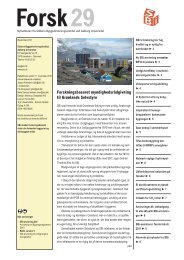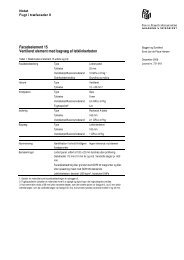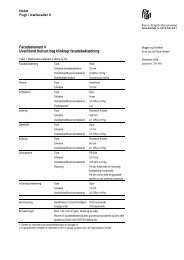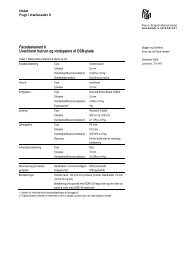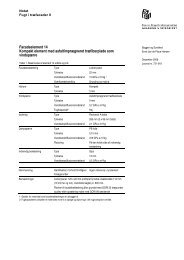Mould growth on building materials - Statens Byggeforskningsinstitut
Mould growth on building materials - Statens Byggeforskningsinstitut
Mould growth on building materials - Statens Byggeforskningsinstitut
Create successful ePaper yourself
Turn your PDF publications into a flip-book with our unique Google optimized e-Paper software.
late produced satratoxins and high quantities of stachybotrylacet<strong>on</strong>es and the later strain<br />
produced <strong>on</strong>ly minor quantities of the latter type. The same group 216 also instilled mice with<br />
10 3 and 10 5 spores of the same two S. chartarum isolates 6 times during 3 weeks. In the<br />
mice instilled with the highest dose, severe inflammatory changes were observed in the<br />
lungs. The mice administered with spores from #72 developed much more severe inflammati<strong>on</strong>s<br />
than the mice instilled with spores from #29. At the lowest level <strong>on</strong>ly the mice instilled<br />
with the spores from the satratoxin producing isolate, #72, developed inflammatory changes<br />
in the lungs. However due to the few isolates used and the variati<strong>on</strong> in both MTR and<br />
stachybotrylacet<strong>on</strong>e producti<strong>on</strong> the study remains partly inc<strong>on</strong>clusive <strong>on</strong> the resp<strong>on</strong>sible<br />
comp<strong>on</strong>ents.<br />
This is the same for the study of Mas<strong>on</strong> et al 217,218 who instilled S. chartarum spores and isosatratoxin<br />
F in the lungs of mice, and observed that both obstructed the lung homeostasis<br />
whereas Cladosporium spores did not. However the S. chartarum spores and the pure toxin<br />
induced very different surfactant producti<strong>on</strong> (P60 and P100 phosphor lipids), but no chemical<br />
analyses were performed <strong>on</strong> the strain so it is unknown if it produced MTR.<br />
Rao et al 219 instilled spores in rat lungs, and showed that when spores from a highly cytotoxic<br />
(presumably a MTR producer) of S. chartarum was methanol extracted, the toxicity of the<br />
spores almost disappeared compared with unextracted spores. This clearly shows that the<br />
pulm<strong>on</strong>ary toxicity is due to extractable metabolites as MTR or most of the metabolites described<br />
in the following subchapter.<br />
The c<strong>on</strong>clusi<strong>on</strong> drawn from these studies is that S. chartarum spores indeed c<strong>on</strong>tains a<br />
number of metabolites which can induce severe inflammati<strong>on</strong>, haemorrhage and death in<br />
animals. However there is no evidence that these effects are <strong>on</strong>ly caused by the MTR.<br />
2.4.1.2 N<strong>on</strong> trichothecene metabolites<br />
Most species in Stachybotrys and especially S. chartarum produces high quantities of a<br />
number of spiriocyclic drimanes 183,220 as<br />
shown in Figure 3. These comp<strong>on</strong>ents<br />
have a number of biological properties,<br />
inter alia inhibiti<strong>on</strong> of TNFα liberati<strong>on</strong><br />
from human macrophages 221 , complement<br />
inhibiti<strong>on</strong> 183,222 and antiviral activity<br />
223 . When c<strong>on</strong>sidering that <strong>on</strong>e of the<br />
most comm<strong>on</strong> symptoms in mouldy<br />
<strong>building</strong>s is recurrent airway infecti<strong>on</strong>s,<br />
HO<br />
HO<br />
metabolites which inhibits the complement system are interesting, as the complemet system<br />
is an important part of our defence against bacteria 143 . A number of triprenyl phenol metabolites<br />
(see Figure 3) have been described from several Stachybotrys species. They are precursors<br />
of the spiriocyclic drimanes, as the triprenyl can be cyclizied into the drimane part.<br />
These metabolites can activate and enhance the plasminogen-mediated fibrinolysis (at levels<br />
down to 100 µM) 224-226 and could in that way be plausible comp<strong>on</strong>ents resp<strong>on</strong>sible for IPH,<br />
as this could account for the brittle blood vessels in the lungs.<br />
Both the triprenyl phenols and the spiriocyclic drimanes are produced by two mixed biosynthetic<br />
pathways, partly by the sesquiterpenoid pathway (shown in blue <strong>on</strong> Figure 3) and<br />
partly by the polyketide pathway. Reviewing the literature <strong>on</strong> these comp<strong>on</strong>ents has been<br />
troublesome as Russian groups have published known structures under new names, data <strong>on</strong><br />
the stereochemistry is often not available, and a significant number of the publicati<strong>on</strong>s have<br />
Page 16<br />
O<br />
O<br />
X<br />
Figure 3. Left, the spiriocyclic drimanes, stachybotrylact<strong>on</strong>e<br />
(X=O) and stachybotrylactam (X=NH). Right, SMTP-1, <strong>on</strong>e of<br />
their precursors.<br />
HO<br />
O<br />
OH<br />
N<br />
O<br />
OH



